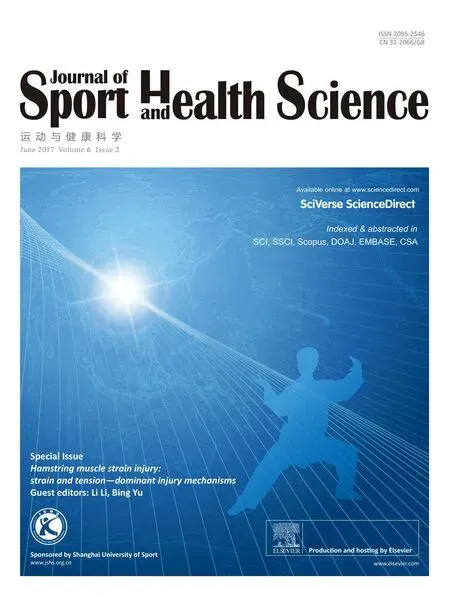Parallel and cross-sectional hamstring injuries in sprint running
Li Li*,Donghai Wang
aSchool of Health and Kinesiolog y,Georgia Southern University,Statesboro,GA 30460,USA
bSchool of Kinesiology,Shanghai University of Sport,Shanghai 200438,China
Parallel and cross-sectional hamstring injuries in sprint running
Li Lia,*,Donghai Wangb
aSchool of Health and Kinesiolog y,Georgia Southern University,Statesboro,GA 30460,USA
bSchool of Kinesiology,Shanghai University of Sport,Shanghai 200438,China
This issue ofJournal of Sport and Health Sciencecontains a point-counterpoint discussion of hamstring injuries in sprint running by the groups of Drs.Liu and Yu.1–4They propose different mechanisms of muscle injuries in general,and hamstring injuries in sprint running speci fically.Yu et al.2,4present evidence suggesting that hamstring injuries are primarily caused by excessive muscle strain during eccentric contraction. In maximal effort sprint running,excessive muscle strains occur at the end of the swing phase.In contrast,Liu et al.1,3point out that,in addition to excessive hamstring strain,high stresses in the late swing and early stance phase and the transition between swing and stance may also contribute to hamstring injuries when the hamstrings actively assist hip extension and knee flexion.
Both groups provide supporting published,scienti fic evidence for their contention.Yet,the entire discussion is based on the assumption that the hamstring muscles contract uniformly in all phases of sprint running.However,the different heads of the hamstring muscles have different insertion sites,structure, and fiber type distributions.Therefore,it is safe to assume that the individual heads ful fill different functions and that they do not elongate at the same rate and that stress across them is not uniform.
Using magnetic resonance imaging in combination with finite element modeling,Fiorentino and colleagues5reported that non-uniformity in fiber strains may also be a contributing factor for hamstring injuries,especially when sprinting at high speeds.We propose that this fiber strain and strain rate nonuniformity at fast sprint speeds could lead to“parallel injury”, tissue separation,and misalignment of myo fibrils along the muscle fibers(e.g.,see Lee and Healy,2012,for a detailed image6).Along these lines,Morgan7proposed the so-called“Popping Sarcomeres Hypothesis”,which is based on the idea that repeated high stresses during eccentric contractions leadsto“tearing”of sarcomeres,and the local damage of sarcomeres leads to more damage in adjacent sarcomeres and neighboring myo fibrils due to the sudden increase in localized stress.We propose that the“Popping Sarcomeres”phenomenon could lead to“cross-sectional”hamstring injuries in which the damage occurs tangential to the fiber orientation and produces disruptions of the Z-lines and misaligned A-bands(see Morgan,1990, for exemplar image7).Parallel and cross-sectional hamstring injuries may have different underlying causes and may provide apost hocpossibility for evaluating how the injury occurred.In severe hamstring injuries(Grade II or more),one might expect simultaneous parallel and cross-sectional injuries.
The detailed mechanisms of hamstring injuries in sprint running remain a question of debate,and it might be time to look at this issue from an altogether different point of view. Considering that hamstring strains and strain rates might be non-uniform across the different heads,it appears feasible that the non-uniform strains and strain rates may lead to“parallel”injuries,whereas non-uniform stresses might lead to“crosssectional”injuries.Considering different and multiple hamstring muscle injury mechanisms in sprint running may lead to more targeted training strategies and provide new insights into the prevention and rehabilitation of hamstring injuries.
Authors’contributions
LL initiated the concept of the paper;LL and DW contributed equally in composition of the essay.Both authors have read and approved the final version of the manuscript,and agree with the order of presentation of the authors.
Competing interests
The authors declare that they have no competing interests.
1.Liu Y,Sun Y,Zhu W,Yu J.The late swing and early stance of sprinting are most hazardous for hamstring injuries.J Sport Health Sci2017;6: 133–6.
2.Yu B,Liu H,Garrett WE.Mechanism of hamstring muscle strain injury in sprinting.J Sport Health Sci2017;6:130–2.
3.Liu Y,Sun Y,Zhu W,Yu J.Comments to“Mechanism of hamstring muscle strain injury in sprinting”by Yu et al.J Sport Health Sci2017;6:139–40.
4.Yu B,Liu H,Garrett WE.Comment on“The late swing and early stance of sprinting are most hazardous for hamstring injuries”by Liu et al.J Sport Health Sci2017;6:137–8.
5.Fiorentino NM,Rehorn MR,Chumanov ES,Thelen DG,Blemker SS. Computational models predict larger muscle tissue strains at faster sprinting speeds.Med Sci Sports Exerc2014;46:776–86.
6.Lee JC,Healy J.Image of lower limb muscle injury.Aspetar Sports Med J2012;1:142–7.
7.Morgan DL.New insights into the behavior of muscle during active lengthening.Biophys J1990;57:209–21.
21 February 2017;accepted 23 February 2017
Available online 4 March 2017
Peer review under responsibility of Shanghai University of Sport.
*Corresponding author.
E-mail address:lili@georgiasouthern.edu
http://dx.doi.org/10.1016/j.jshs.2017.03.002
2095-2546/?2017 Production and hosting by Elsevier B.V.on behalf of Shanghai University of Sport.This is an open access article under the CC BY-NC-ND license(http://creativecommons.org/licenses/by-nc-nd/4.0/).
 Journal of Sport and Health Science2017年2期
Journal of Sport and Health Science2017年2期
- Journal of Sport and Health Science的其它文章
- Erratum to“Effects of music and video on perceived exertion during high-intensity exercise”[J Sport Health Sci 6(2017)81–88]
- Erratum to“A systematic review of active video games on rehabilitative outcomes among older patients”[J Sport Health Sci 6(2017)33–43]
- Erratum to“Children’s expectancy beliefs and subjective task values through two years of school-based program and associated links to physical education enjoyment and physical activity”[J Sport Health Sci 5(2016)500–508]
- Promoting physical activity among Chinese youth:No time to wait
- Could titin have a role in strain-induced injuries?
- Comments to“Mechanism of hamstring muscle strain injury in sprinting”by Yu et al.
